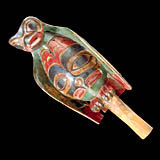



 |
The First Peoples Hall
The Story
Introduction
The First Peoples Hall occupies 2,000 square metres (20,000
square feet) of Level 1. This is larger than many museums in
Canada. The actual footpath from start to finish is half a
kilometre long. A quick visit will take one hour, but a more
detailed visit could last half a day.
Zone 1 - Greeting Orientation
A greeting by the Algonquin people of Kitigan Zibi and images
of many Aboriginal peoples introduce visitors to the First
Peoples Hall. This is the start of a voyage that explores
Aboriginal cultures, history, ways of living and community
experience.
Zone 2 - Diversity and Origins
This zone establishes the four themes of the Hall: We are
still here, We contribute, We are diverse
and We have an ancient relationship with the land. The
themes are explored through mini-biographies of Aboriginal
people from the past and present; historical and contemporary
objects and works of art; photographs, videos and maps that
show the homelands of the many Aboriginal peoples in Canada; and
Aboriginal place names which have changed, disappeared and
re-emerged over the last five hundred years. The long history of
Aboriginal settlement is evoked in a reconstruction of the
archaeological dig at Blue Fish Caves in the Yukon Territory,
while the creation narratives told in Aboriginal communities for
centuries are told once again, both in story form and in works
by contemporary Aboriginal artists.
Zone 3 - Survival and Cooperation in
Ancient History
This zone recreates five environments from pre-European times
that reveal the Aboriginal relationship to the land in greater
depth. We move from the mixed hunting and fishing economies on
the Atlantic Coast, to whale hunting in the Arctic, communal
hunting on the Plains and in the sub-Arctic forests, and the
farming of the Iroquoian nations of the Eastern Woodlands. The
exhibits show economic techniques, systems of family
relationship and beliefs that developed over thousands of years.
The last component is a trade fair set on the edge of the Great
Plains five hundred years ago. It is a dramatic recreation of
the trade relationships that connected peoples from distant
homelands and brought together hundreds of people at particular
times.
Zone 4 - Arrival of Europeans and Modern
Existence
Beginning with the arrival of Europeans and first contact -
an event that actually took place in different parts of Canada
at various times between the eleventh and twentieth
centuries - the fourth zone explores the history of
Aboriginal people over the past five hundred years. The first
modules present the impact of European colonization, the
establishment of early trade and social relations, the coming of
epidemics, the decline and death of the Beothuk, the development
of the concept and word "Indian," and the birth of the
Métis. This zone explores the impact of Christian
missions on Aboriginal beliefs, the changing relationships
between Aboriginal governments and the emerging Government of
Canada, and the impact of both on Aboriginal economies and
relationships with the land. The concluding modules of the Hall
reaffirm Aboriginal identity, culture and creative and political
forces, exploring contemporary beliefs, social gatherings,
political and legal affirmation and the rise of contemporary
Aboriginal art.
Authenticity in Artifacts
The First Peoples Hall brings together approximately 2,000
historical objects, contemporary works of art, historical
illustrations, photographs and videos from the Canadian Museum
of Civilization collection and other public and private
collections.
Audio and Film
There are several videos, background audio-visual programmes
and three theatres in the First Peoples Hall. The first theatre
presents the Mi'kmaq creation story. An audio theatre offers
visitors six Aboriginal narratives. Finally, a small theatre
near the exit of the Hall presents a video on contemporary
Aboriginal people and perspectives.
Concluding Message
The First Peoples Hall ends with the words of Georges Erasmus:
"The history of our people needs to be told. We need to
present accurately what happened in the past, so that we can
deal with it in the future... I don't like what has happened
over the last 500 years. We can't do much about that. But what
are we going to do about the next 500 years? What are we going
to do about the next ten years?" - In Canadian
Forum, 1992
|

